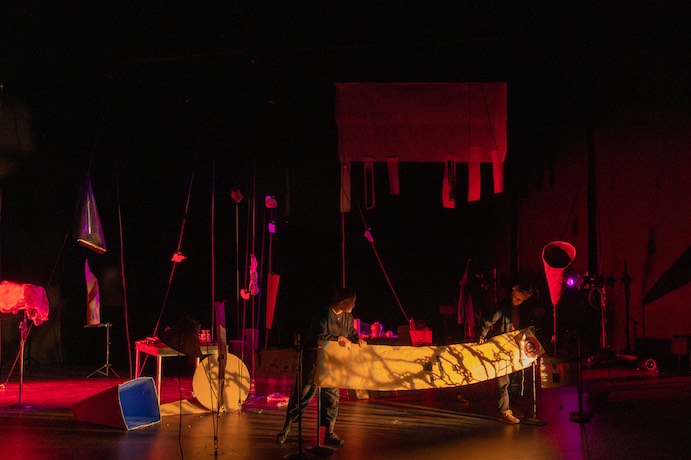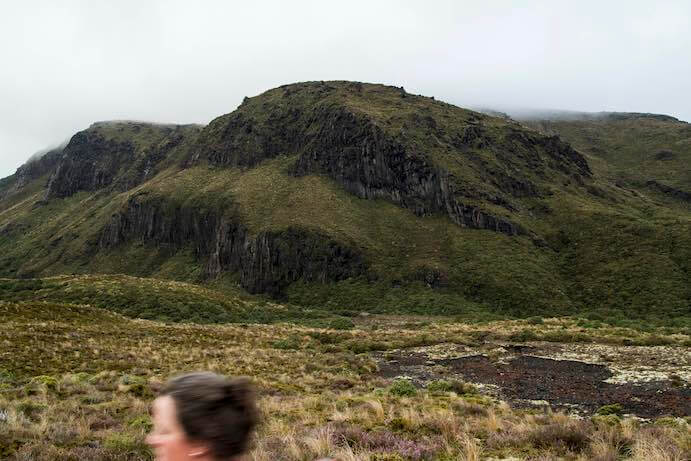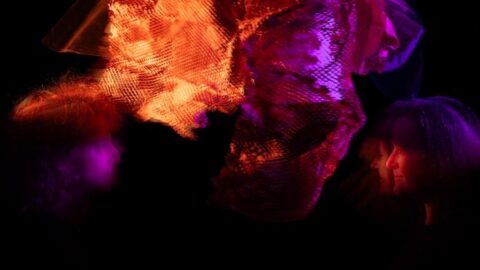Hidden in a small port on our smartphone. Nestled on lapels. Disappearing on booms just out of frame. Microphones and audio technologies are so ubiquitous in 21st century life that they almost become invisible. Yet, the relationship between specific technologies and music subtly shape how we hear the world. The “precision” of German microphones is linked to classical music. Bluegrass ensembles lean into condenser microphones that highlight their instruments’ acoustic sounds. But what if the cultural and artistic relationships between audio technology and sounding bodies were opened up to experimentation?
Individually, composers Jessie Marino and Antonia Barnett McIntosh have explored how everyday sonic experiences are transformed through media and performance. Marino’s seriously playful theatrics in works like Guillaume de St. Cloud Suffers a Violent Dazzling reframe familiar sounds (radio static) through repetition and video. Barnett McIntosh’s output thoughtfully amplifies the musicality of language, listening, and conversation through works like earpiece and accent.
Recently, both are increasingly turning to the social spaces between music and media technologies. Marino’s radio operas riff on Robert Ashley to create auto-poetic narratives that cross from the performance hall to the digital world. Barnett McIntosh expands her previous work on the gender politics of conversation in Wild Fabrics-you couldn’t really tell, a “sonic visual postcard” that bridges the gap between social and physical spaces.
Now the duo have teamed up for the first time for the Extended Microphone Project, which foregrounds the often invisible relationship between microphones and the objects they record and amplify. Through a commission and residency from the Experimental Media and Performing Arts Center (EMPAC), Marino and Barnett Mcintosh have been developing experimental microphones tailored to specific musical bodies and spaces. After a work-in-progress presentation on January 17 curated by Amadeus Julian Regucera, the duo are preparing to premiere Susceptible Chambers at EMPAC on Friday, Apr. 5.
We caught up with Marino and Barnett McIntosh to talk about their artistic practice, their residency, and the upcoming performance.

Both of your artistic practices are richly interdisciplinary, but center around questions of musical material, form, and intermedia performance/art. Can you both describe what sparked your interest in each other’s work?
JM: I had seen Antonia and collaborator Emma Bennett perform at the Weisslich Series in London and loved their piece ‘Accent’ – it struck me that Antonia and I shared a strong interest in illuminating the ‘everyday’ in our practices- sounds, sights, speech, movements, textiles, media – can all be sourced from a simple walk around the block and framed in a way to make them gorgeous and permeable to acts of performance.
ABM: Jessie’s work does for me what I like an audience member to leave a performance of my work feeling — like, if even for a moment, half an hour, or until the next day, they experience an aspect of the world around them anew, hear something quotidian in a different way, see musicality in the mundane… By highlighting and focussing on a single sound, musical element, or gesture that is usually unheard or unobserved, we try to shed new light, a different angle, multiple angles, a radiant glow of the ordinary hooning towards you absurdly.
Can you talk a little bit about the history of the Extended Microphone Project, especially the initial workshops in Melbourne/Naarm?
JM: I had the idea for building organic microphone filters swimming in my head for some time and was looking for a person who would also be interested in exploring this concept. There was a funding opportunity through the Akademie der Künste, in Berlin, that was specifically calling for proposals from new collaborations to get their ideas off the ground. I wrote to Antonia to propose the Extended Microphone idea and the possibility of actually getting together to discuss it (I live in Berlin and Antonia lives in Tāmaki Makaurau Auckland). When we met in Naarm Melbourne, we spent our time exploring botanical gardens, coffee shops, the moods of different neighborhoods and had a particularly fruitful trip to an exhibition at a public library (ANTONIA! Do you remember the name of the exhibition?) where we came across the term “fancy work” which became a kind of grounding term/concept for the whole piece. After our initial test drive I proposed to Amadeus Regucera that we continue our collaboration as Artists-in-Residence at EMPAC.
ABM: We got chatting over email during the pandemic, kinda like 90s penpals, with long gaps in between (as was common in that time), after Jessie reached out asking to perform another collaborative work I’d made with Emma Bennett, called Accent. That exchange led to mutual fangirling and Jessie came to me with a proposal for the Extended Microphones Project (EMP). We met up in Naarm Melbourne—I timed a trip specially for when Jessie was visiting for another project, and we enjoyed a week collaborating through chat, long walks, and delicious food and cocktails. We went to an exhibition at the State Library Victoria called Handmade Universe: From craft to code and the spaces between (got you!), took pictures of potential filter ideas at “The Tan” (Kings Domain + Royal Botanic Gardens), and dreamt up a cosmic vision for what EMP could become. Fancy. Work. By the end of our days there, Jessie had a lightbulb moment and proposed our idea to Amadeus at EMPAC.

How has the residency at EMPAC shaped the project? What new questions, resources, and collaborative working methods have you explored?
JM: Having an immense amount of physical space to work in and the fantastic contributions from the EMPAC technicians has been a huge influence on the work – things can be BIG! (a dream of the theater, but not normally available to concertizing musicians) — and who knew that it is possible to do projection mapping at the scale of a single pixel?! — this play of scale has been a fantastic opportunity that EMPAC has offered.
ABM: EMPAC has opened up so many alternate pathways for this project, more than we could possibly utilize. Early on, we had to keep reminding ourselves to upsize — scale up! Of course, we are also DIYers keenly interested in “just how things are”. This gentle tension has led to fruitful conversations in our collaboration with the EMPAC team, in the space where we meet in the middle. How to rig a huge pulley system and get real specific about where and how we’d like it to zig and zag, how to generate the language to describe the lighting states we’re imagining in our minds, what we are even calling some of the objects we have created. For me, collaboration often occurs via (attempted) description — it’s been a lot of fun!

Can you give us a preview of what microphone/sound relationships you’ll explore in the world premiere of Susceptible Chambers?
JM: This is difficult for me to put into words! But what I can definitely say is that fidelity is NOT the intention! Microphones are typically designed to bring an ear a very accurate representation of the sound it is capturing – whether it be an extremely close up auditory image or one that captures more of a room/architecture. These microphones have been designed to be extremely unfaithful in their rendering of an auditory image – and so they become instruments unto themselves, an audio mystery – microphones buried deep in a hoop of dried physalis leaves being tickled by a stalk of feathery wheat and an old electric toothbrush. This project, for me, is not about an academic or supremely technical investigation of microphone cabinet design. It’s about listening and offering a bevy of different filters which allow one to focus on new aspects of a sound or object that had previously gone unnoticed.
ABM: We have handmade and sourced second-hand most of the objects to be used as filters for the microphones and instruments for those filters to interact with. Ceramics like terracotta pots, modernist glass sconces, fabric, papier mâché, needlepoint, pine needles, oyster shells, rice, lanterns, lampshades, cones, gloves, card… We’ve also taken experiences we’ve had while out and about, like a blackout, to inform some of the special formal moments during the performance. (I wholeheartedly echo Jessie’s sentiments around microphone cabinet design — we are here for the PLAY!)

How has experimenting with microphone materials artistically shaped your thinking about broader issues facing music technology, like sustainability (e.g. rare earth metals) and ethics (e.g. gender and recording technology)?
ABM: Collaborating internationally means a massive carbon footprint due to long haul flights. That’s easily my biggest environmental guilt about taking on this project. At home, I mostly bike and try my best to live low-zero waste. In Troy, we have also tried to be as low waste as possible: where we can, we have reused materials and sourced items from op shops (op is for opportunity, a charity shop, or thrift store); the things we’ve built, including the microphones, can be used multiple times. The gendered nature of this work is a much longer conversation…
JM: For me, this question needs much more than the word count allowed to be thoughtful, nuanced, and accurate in my views on this subject. A question very important to thoroughly discuss! What I can say is that the DIY playspace is vital to me being comfortable in pursuing new interests in technology — be they microphone design, machine quilting, or hand-stitched embroidery.
I CARE IF YOU LISTEN is an editorially-independent program of the American Composers Forum, and is made possible thanks to generous donor and institutional support. Opinions expressed are solely those of the author and may not represent the views of ICIYL or ACF.
You can support the work of ICIYL with a tax-deductible gift to ACF. For more on ACF, visit the “At ACF” section or composersforum.org.
























